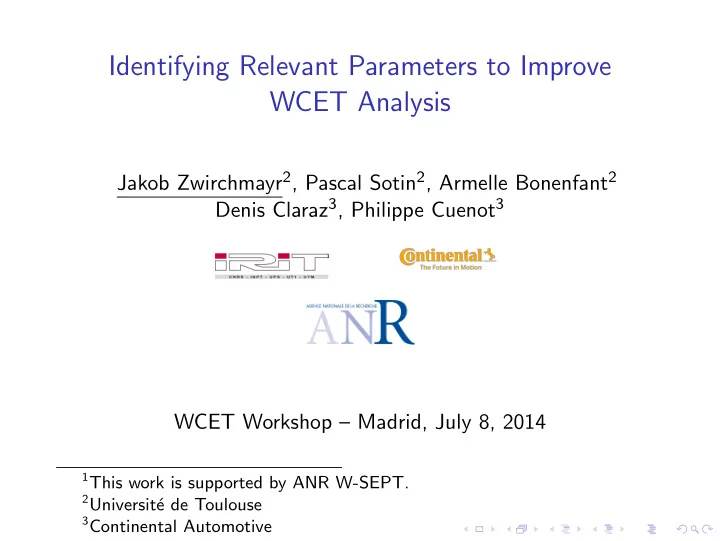

Identifying Relevant Parameters to Improve WCET Analysis Jakob Zwirchmayr 2 , Pascal Sotin 2 , Armelle Bonenfant 2 Denis Claraz 3 , Philippe Cuenot 3 WCET Workshop – Madrid, July 8, 2014 1 This work is supported by ANR W-SEPT. 2 Universit´ e de Toulouse 3 Continental Automotive
Introduction ◮ W-SEPT: eliminate sources of imprecision on all levels ◮ highly configurable systems (“product platforms”)
Industrial Context ◮ collaboration with Continental Automotive ◮ WCET analysis of a software module are our tools appropriate? ◮ analysis during design phase (size hardware) ◮ analysis during development (compliance) ◮ analysis of configurations/parameters
WCET Context ◮ OTAWA toolbox ◮ oRange analyzer requires ◮ module harness (run) ◮ stubs for dependencies (compilation)
WCET Context ◮ WCET analysis: valid (safe) estimate ◮ problem: not really useful high overestimation due to unspecified configuration ◮ configuration/parameters = “scenario”
Infeasible Paths due to Scenarios ◮ configuration can be specified in harness ◮ “disables” some (originally valid) execution paths ◮ → more precise estimate for the config scenarios ◮ expert knows a (large) set of parameters/configuration variables ◮ for each, the expert specifies possible values ◮ specification is tedious
Goal automatic selection of “relevant” variables ◮ “relevant” variables: enable or disable “heavy” branches ◮ “light” branches don’t matter ◮ but are similarly tedious to specify infer relation between parameter variables and “heavy” branches ◮ “heavy”: branch is much more expensive than alternative ◮ ask expert for specification of only those ◮ compute a more precise estimate for the config
Workflow
Workflow ◮ identify relevant parameter variables from the set ◮ get additional constraints/assumptions only on those (expert) ◮ WCET analyze the module under the given assumptions → profit from additional specification → keep specification effort low (no need to identify relevant parameters manually)
Principle of the Analysis ◮ source-based analysis to identify “unbalanced” conditionals ◮ simple matching with set of parameters ◮ use spec of those, if possible without modifying the harness ◮ branching statement analysis ◮ uses information inferred from high-level analyzer oRange (loopbounds, executed) ◮ outputs a selection of parameter variables ◮ encode them as input annotations to oRange ◮ exploit (output) flow facts in OTAWA
Branching Statement Analysis ◮ source-based, simple cost model (can be updated) ◮ on (internal) oRange representation (AST) ◮ weight computed bottom up from AST nodes ◮ input: C program ◮ output: list of locations, branches, ∆-value and condition ◮ ∆-value: indicates “unbalancedness” of branches ◮ match ∆-conditions to parameters
Output of the Analysis #include "missing.h " int main () { for (int i = 0; i < 100; i ++) if (max_speed > 250) expensive (); else cheap(); Computing the balance information for the main function Estimated cost of the function : 70804 1 accessible conditional statements Delta 65000 at rex.c :22 in main (total count = 100) : then = 704; else = 54; // max_speed > 250
Eliminating Infeasible Branches ◮ eliminating infeasible branches on the WCETP improves estimate ◮ “heavy” v.s. “light” ◮ if not on the WCETP, improvement is possible as well no improvement: ◮ “witness for accuracy” ◮ scenario-WCET coincides with WCET
Continental Use-Case ◮ module of 700 loC ◮ list of 85 possible parameters (existing) ◮ scenario specifying 30 parameters (expert chosen)
Results ◮ scenario exec-t. coincides with WCET, nevertheless: ◮ relevant parameters are identified: 20 of 30 in ∆-conds ◮ matches 18 parameters in 10 highest ∆ ◮ parameters not listed in ∆-conds have “no relevance” (0.3%) ◮ 3 most relevant variables have high impact
Conclusion ◮ BSA does indeed identify relevant parameters ◮ exploiting them in scenarios is possible ◮ can be applied early, hinting at relevant parameters ◮ decreases/eliminates manual effort to identifying them
Future Work ◮ more realistic cost models ◮ matching conditions ↔ parameters (dependencies) ◮ richer input annotation (intervals, relations) ◮ exploiting additional information in OTAWA (e.g. executed) ◮ combine with counter-based program analysis techniques (e.g. identify important counter locations)
Recommend
More recommend